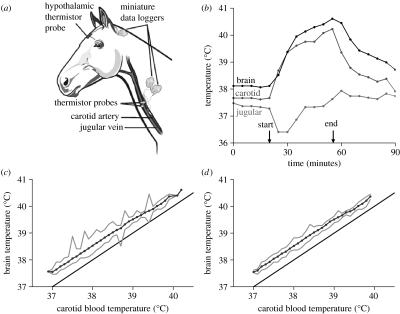Figure 1.
(a) Sites on horses at which temperatures were measured with implanted miniature thermometric loggers. (b) Blood and brain temperatures recorded at 5 min intervals in a free-living horse, at 32 °C globe temperature. Except for a short transient at the beginning of exercise, brain temperature exceeded carotid blood temperature before, during and after exercise. The difference between jugular venous blood temperature and carotid arterial blood temperature widened during exercise. (c), (d) Plots of mean, maximum and minimum hypothalamic temperature recorded at each 0.1 °C class of carotid blood temperature, and the line of identity, showing all data collected in horses at rest (lower end) and exercise (higher end), over 11 days ((c) 3168 data points and (d) excluding the 315 data points for which carotid blood temperature changed by 0.1 °C or more in the preceding 5 min). Except during the occasional transients, hypothalamic temperature always exceeded carotid blood temperature.

